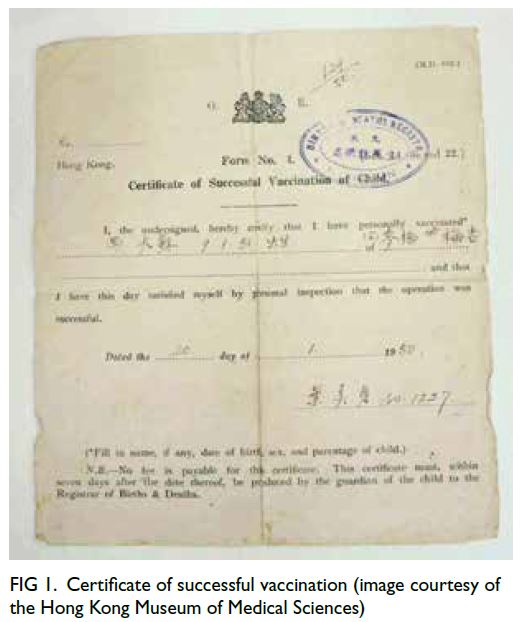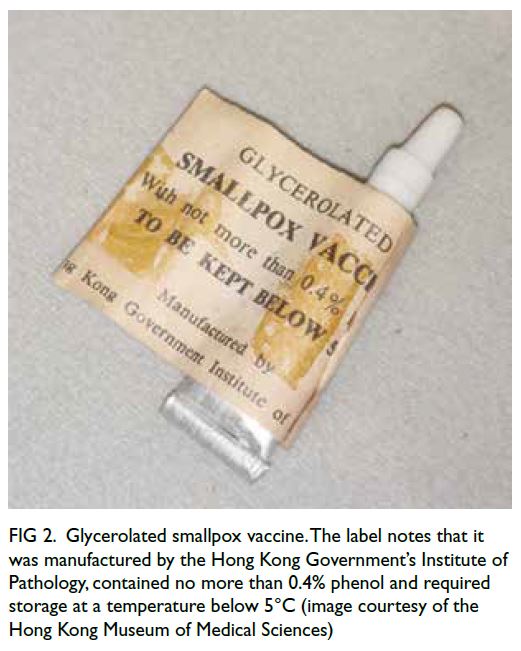© Hong Kong Academy of Medicine. CC BY-NC-ND 4.0
REMINISCENCE: ARTEFACTS FROM THE HONG KONG MUSEUM OF MEDICAL SCIENCES
A smallpox vaccination certificate
WP Mak, FHKAM (Pathology)1; TW Wong, FHKAM (Emergency Medicine)2
1 Chairman, Hong Kong Museum of Medical Sciences Society
2 Director, Hong Kong Museum of Medical Sciences Society
Compulsory vaccination in Hong Kong began in
1888, when the Vaccination Ordinance was enacted
in response to a severe epidemic the year before.1 All
infants were required by law to be vaccinated before
the age of 6 months, and only vaccination performed
by a medical practitioner or a government-appointed
public vaccinator was recognised; unauthorised
persons who performed inoculations would be
penalised. A certificate of vaccination would be
issued and the parents were required to register
the vaccination with the stipulated government
department within a specified period.2
This certificate of successful vaccination (Fig 1) was issued for a smallpox vaccination in January
1950. The vaccinator was a Ms Mei-ching Yip,
a midwife who ran a private maternity home in
Shanghai Street, Yaumatei, Kowloon. Because the
baby was unnamed at the time, it was recorded on
the certificate as ‘Tai So’ (大蘇), meaning ‘firstborn
boy’. The parents then took this certificate to the
Registrar of Births and Deaths where a stamp was
made on the right upper corner of the certificate as a
proof of registration.

Figure 1. Certificate of successful vaccination (image courtesy of the Hong Kong Museum of Medical Sciences)
Vaccination was an important measure for the
control of smallpox in Hong Kong. The vaccines were
produced initially by the Vaccine Institute, which
was established in 1892. Production was taken over
by the Bacteriological Institute in Sai Ying Pun from
1906 until 1973, when the Institute of Immunology
was opened in Victoria Road, Pokfulam.3 The
smallpox vaccines (Fig 2) were produced using
various techniques, including injection of pox
viruses into the bellies of buffalo calves. The number
of smallpox vaccines produced rose from 8797
in 1906 to 17 536 in 19083 and the vaccines were
distributed to various local clinics, hospitals, and
maternity homes; the Bacteriological Institute was
also able to supply vaccines to some neighbouring
cities.4 A variety of special vaccination knives
and techniques were used at this time to ensure
success.5

Figure 2. Glycerolated smallpox vaccine. The label notes that it was manufactured by the Hong Kong Government’s Institute of Pathology, contained no more than 0.4% phenol and required storage at a temperature below 5°C (image courtesy of the Hong Kong Museum of Medical Sciences)
Around 1950, smallpox vaccination was no
longer compulsory and instead became one of the
recommended immunisations for a child. As well
as the vaccination of newborn babies, revaccination
at school entry was also introduced. The last local case of smallpox was recorded in 1952. Hong Kong
was declared smallpox-free on 30 July 1979 by the
Hong Kong Government and the World Health
Organization announced the global eradication of smallpox later that year. On 1 January 1981,
smallpox vaccination was formally deleted from the
immunisation schedule and supply of the vaccine to
medical practitioners was also discontinued.6
References
1. Chan-Yeung M. A Medical History of Hong Kong: 1842-1941. Hong Kong: The Chinese University of Hong Kong Press; 2017: 211-7. Crossref
2. The Vaccination Ordinance, 1890. Historical Laws of Hong Kong Online. Available from: https://oelawhk.lib.hku.hk/archive/files/7744fd4e98b3640e9f660c2b3d10668a.pdf. Accessed 5 Jan 2024.
3. Starling A, Ho FC, Luke L, Tso SC, Yu EC. Plague, SARS and the Story of Medicine in Hong Kong. Hong Kong: Hong Kong University Press; 2006: 24-5.
4. Ho FC. The Silent Protector–Hong Kong’s Bacteriological Institute, its History and Legacy. Hong Kong: Hong Kong Museum of Medical Sciences Society; 2020: 37-8.
5. Chan-Yeung M. Vaccination knife. Hong Kong Med J 2017;23:670-1.
6. Lee SH. Epidemiological Surveillance of Communicable Diseases [MD thesis]. Hong Kong: University of Hong Kong; 1991: 203-15.

